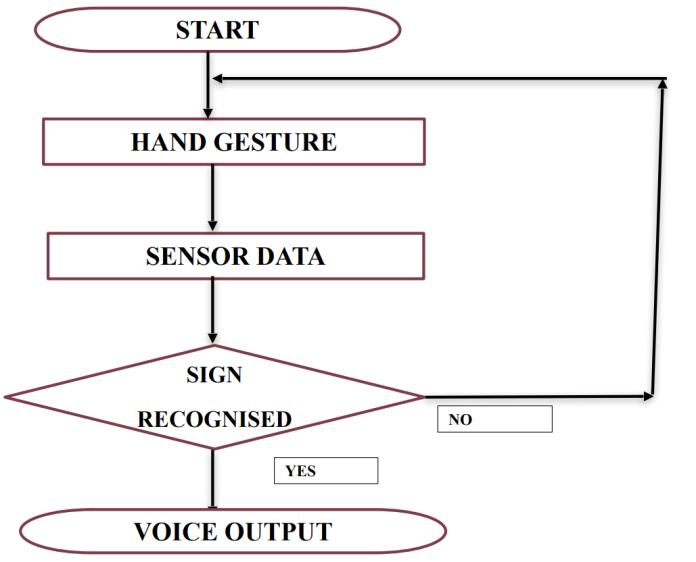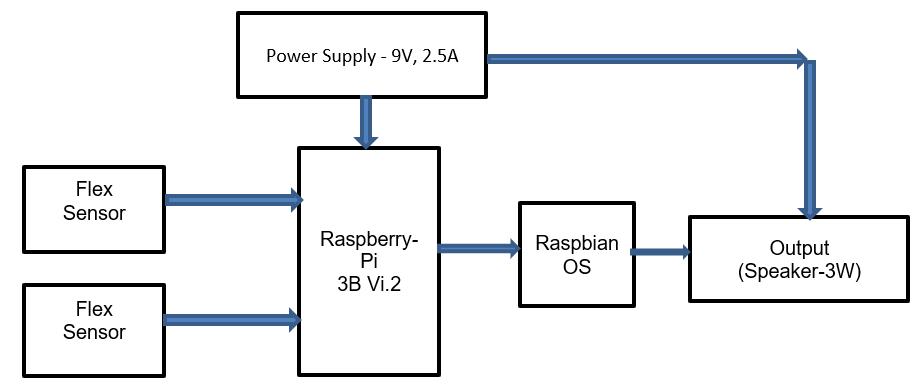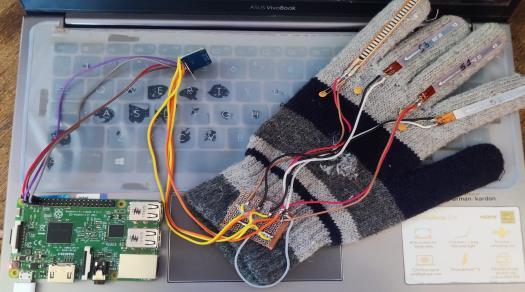HAND GESTURE BASED SPEAKING SYSTEM FOR THE MUTE PEOPLE
Gaurav Dharankar1 , Devavrat Yende2 , Prachi Ghadge3, Snehal Gawhale4
1Gaurav Sunil Dharankar, Student at PES Modern COE in Department of E&TC Engineering, Pune, Maharashtra, India
2Devavrat Prashant Yende, Student at PES Modern COE in Department of E&TC Engineering, Pune, Maharashtra, India
3Prachi Hanumant Ghadge, Student at PES Modern COE in Department of E&TC Engineering, Pune, Maharashtra, India
4Snehal Shrikrushna Gawhale, Student at PES Modern COE in Department of E&TC Engineering, Pune, Maharashtra, India
5Anuradha Kasangottuwar, Assistant Professor at PES Modern COE in department of E&TC Engineering, Pune, Maharashtra, India
Abstract - - Communication between Mute community has become more unfavourable in day-to-day life. Approximately 432 million people across globe are deaf and mute, and around 34 million out of these are children. Mutegroupsinthe world mosty use gestural type of communication called Sign language. We ideated a verbal exchange device for the DeafMute which translates hand gesturesintoaudiomessageasan intermediatory. The aim behind developing this plan, is to assist the humans using a deaf-mute communication intermediatory device. InthePrototype, weutilizedFlexsensor module to understand hand motions. The motions of the fingers of mute people is captured by flex sensor, raspberry pi 3B+ identifies these gestures. Now using text to speech conversion these gestures are then converted into adequate and predefined audio messages and audio output is given through speaker module. Thus more effective communication is enabled. The developed system it is easy to operate and capable to building efficient and effective interactionbetween human and computer and also user friendly.
Key Words: Text to speech conversion, Raspberry pi 3B+, Flex Sensors, ADC ADS1115
1. INTRODUCTION
Itbecomesdifficultformutepeopleforconveying theirmessagetoregularpeople.As,regularpeoplearenot trained on hand sign language, Hence the communication becomes very difficult. In emergency situations or other times communicating to nearby people or effectively explainingtheirthoughtsbecomesamajortask.Sotosolve theweproposeasmartspeakingsystemwhichmakesuseof hand motions and gestures and hence assists mute communityinimpartingtheirmessagetonormalpopulation. The device hardware includes a system of hand motion readingincorporatedwithFlexsensorandmicrocontroller. Forprocessingthereceivedinput andoperatingthesystem aRaspberrypiprocessorisused.Thedevicesincludessome inbuilt messages like “I need water”, “I want to use the
washroom” and a few more messages that help mute in impartingbasicmessagesthroughfingeractions.
1.1 Objective
Focused on developing a device for Mute communitythatisindependentofhardwareandfeasible touse.
InseveralfieldsHandgesturesareusedasaform ofnon-verbalcommunication.
The device consists of a Flex Sensor, to capture the finger gesture performed by the user, connected with raspberry pi and captures the signalastheinputtotheproposedalgorithmand produce voice messages as output through the speakermodule.
The sample algorithm divided into four main steps, which includes capturing, analog signal conversion to digital, pattern matching and classification.
The final output is given through speaker module
1.2 Applications
Gesturerecognitionandconversion.
AsatranslatingdeviceforMutepeople.
Education and Learning: Itcanaidinclassroom participation,enablingstudentstointeractwith teachers and classmates more effectively. Additionally,itfacilitateslanguagelearningand vocabularydevelopment.

Medical and Healthcare:toassistpatientswith speech and hearing impairments in conveying their needs, symptoms, or medical history to healthcareprofessionals.
Accessibility in Public Spaces: suchaslibraries, museums,ortransportationhubs,usingitmute individuals caneasilycommunicatewithstaffor accessinformationwithoutbarriers.
2. RELATED WORK
[1] Bhavana Deore, Rachana Bansode, Vaishnavi Kokate, theproposed systemmakes useofa handmotionreading systemequippedwithIRsensorandMobileApplication.This systemispoweredbyabatterypoweredcircuitrytorunit Major Drawbacks were Lesser accuracy due to IR technology,alsoHeftyandimmobile

[2] Tripathy, A. K., Jadhav, D., Barreto, S. A., Rasquinha, D. & Mathew S. S., Asystemthatusing realtimeimagesto convertthemtospeechwithtextusingwebcamandimage processing, the system was Inaccurate and unreliable in darker environment and More time consuming for processing.
[3] Ruize Xu, Shengli Zhou, and Wen J. Li, A system consisting gesture recognition model producing output based on the input signals from MEMS 3-axes accelerometers. The system had Lesser and Limited hand gesturesrecognitionandregularsystemupdatingishectic duetooutdatedtechnologyusage.

3. PROPOSED METHODOLOGY
Raspberry-Pi: Raspberry-Pi processor constantly receivesinputsensorvaluesandthenprocessesit.Now wematchthissignalusingtheif-elseladderalgorithm searchformessagesformthepredefinedvalues.

Speaker Module: aftermessagematching,thismessage is captured and is converted using text to speech processingandspokenoutthroughthespeaker.
Thuswehaveadesignedafullyoperationalsmartspeaking glovesystemwhichassiststhemutecommunitytoefficiently convey, effectively explain their message and easily communicatewithregularpeopleusingasimplewearable system
Description:
Theblockdiagramconsistsofdifferentblockswhichshows theentireschematicoftheproject.
Flex Sensors:theyareusedtodetectthemotionofthe hand. Based on the pattern of bending of fingers the appropriate signal is generated and sent to the processorthroughADC.
Algorithm:
The Pattern Searching algorithms are sometimes also referredtoasStringSearching.HereIfelseladderisusedto generatetheaudiooutput.Uponbendingtheflexsensors,a change is observed in the threshold value of the sensor output. There are predefined threshold ranges, and if the receivedthresholdvaluefallswithinanyofthepredefined rangestheaudiomessageassociatedwiththatrangeisgiven atthevoiceoutput.
1. Basedonthecombinationofthefingers gestures anappropriatepatternissenttotheraspberrypi usingFlexsensorthroughtheADC.
2. Forevery1secondtheprocessorchecksforsensor data.
3. The received pattern is then allowed to pass throughaif–elseladder.
4. This signal is matched to the pre-defined text messages.
5. Signalmatchinginif-else:
YES-Ifthesignalpattermatchestotheconditionof the if statement, the body of the if statement gets executed, and message associated with it is convertedtoaudiothroughtexttospeechlibraries andaudiooutputisgiven.
NO-Ifsignalpatterndoesnotmatchthentheloop terminates and wait for the next hand motion for every1secondtocheckfortheadequatematch
4. RESULTS
1. Testing and Quality assurance:
Wetestedourprojectsgivingvariousinputsusing different hand gestures, it was giving all the samples successfullyasoutput.Itprovidedoutputwith90-95% accuracy.Theflexsensorsareverysensitive,henceeven asslightbendwillchangetheinputinstantlyandhence givetheoutput.Hence,theuserdoesnotneedtobendit toomuch,alittlealsoisfine.Thisgivestheassuranceof quality of our product. Also, the flex sensors are very lightweight.Sotheuserwon’tfeeltroubleinhandling theglovesatall.Hence,wehaveformedauser-friendly product.
2. Problems Faced:
The most challenging part of our project was calibratingtheflexsensors.Themainproblemwasthat every sensor gives a different set of values when it is straightaswellasforwhenitisbent.Theonlythingthat couldbeusedwasthatallthesensorsgavehighervalues forwhenitwasbentthanwhenitwasstraight.Sowe used this logic to solve the issue. We coded the Raspberryinsuchawaythatthresholdrangeswhereset foreachsensorsandifanysensorvaluesisencountered inbetweenthisrangeadequateoutputwasgiven.Also interfacingflextoraspberrywasadifficulttasksowe needADCtodoso.
5. CONCLUSION
In this work, the gestures made by the speech impaired people are caught by the flex sensors which produce a certainvoltagethesereadinghaveaspecificmeaninginthe procureddataandwouldbeshown.Thishelpsincovering thecommunicationgapbetweennormalpeopleandspeech impaired as the message in converted to speech. The connection of these flex sensors to the gloves gives an advantageofcarryingaroundeasyandveryefficient

6. ACKNOWLEDGEMENT
Wearehighlyprivilegedtoexpressourspecialthankstoour projectguide,Mrs.AnuradhaA.Kasangottuwar,Department of Electronics and Telecommunication Engineering, P.E.S. ModernCollegeofengineeringforguidingusthroughevery obstacle and guiding us throughout the process of completionoftheTask.
7. REFERENCES
[1] Bhavana Deore, Rachana Bansode, Vaishnavi Kokate, Prof. Mokashi, “ Hand Gesture recognition system for mute people ”, International Journal of Computer EngineeringandApplications,VolumeXV,IssueV,May 2021.
[2] Tripathy,A.K.,Jadhav,D.,Barreto,S.A.,Rasquinha,D.,& Mathew,S.S.“Voiceforthemute.”,2015International Conference on Technologies for Sustainable Development(ICTSD).doi:10.1109/ictsd.2015.7095846.

[3] Ruize Xu, Shengli Zhou, and Wen J. Li,” Mems Accelerometer Based Nonspecific-User Hand Gesture Recognition”IEEESensorsJournal,Vol.12,No.5,May 2019.
[4] ApoorvaNa,GowriUUrsb,MeghanaRaoJc,Roshini Md , Prof.Syed Salime,” Hand Gesture Recognition System for Deaf and Dumb Using IOT”, International Journal of Research Publication and Reviews Vol (2) Issue(7)(2021).
[5] TanTianSwee,Ariff,A.K.,Salleh,S.-H.,SiewKeanSeng, & Leong Seng Huat.. “Wireless data gloves Malay sign language recognition system”. 2007 6th International Conference on Information, Communications & Signal Processing.doi:10.1109/icics.2007.4449599.
[6] https://ieeexplore.ieee.org.
[7] https://www.ijres.org.
